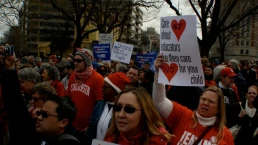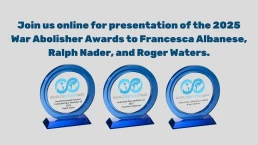Labor scholar Kate Bronfenbrenner explains how workers have helped usher in a new era of union militancy.
by Glenn Daigon, The Progressive
These days, organized labor appears to be doing better than it has in decades. The Teamsters, the United Auto Workers, the Screen Actors Guild, and the Writers Guild all won major gains after large-scale collective bargaining campaigns this year. Can organizers build on this momentum? What tactics will work and what challenges lie ahead?
Kate Bronfenbrenner, a leading labor academic and director of labor education research at Cornell University’s School of Industrial Relations, provided The Progressive with some insight on the future of labor.

Q: Some say that because American unions are organized by Locals rather than industrywide, they are ineffective. They think that Locals are mainly interested in maintaining their own fiefdoms rather than organizing industry-wide campaigns like those seen in Europe. Is that criticism valid?
Kate Bronfenbrenner: The definition of a Local is so different with each union, that you can’t really say that. In SEIU (Service Employees International Union), for example, the Locals are bigger than probably more than half of the unions in the United States. In other unions, like the Steelworkers, the Locals are each plant. [With] SEIU, most of the organizing is happening at a Local.
It is more that there are small Locals that don’t have the resources. In some unions, the leaders work part-time in the bargaining unit, and the International is not giving them the funding, [so] yes, there is going to be an issue. [There are] organizing drives where the Locals all connect with each other and the International is not doing any organizing but the Locals go and organize. There is really so much variety that you can’t make a statement like that.
Recent Posts
Politicians Are Betraying Gen Z On Climate
July 10, 2025
Take Action Now While Gen-Zers thrift, knit, crochet, and find other ways to reduce our footprints, Trump and the GOP are greenlighting more climate…
Trump’s Deportation Threat Against Zohran Mamdani Is Shameful
July 10, 2025
Take Action Now In only half a year of Donald Trump’s presidency, he and his allies have turned deportation into an explicitly political threat…
Teachers Union Votes To Cut Ties To The Anti-Defamation League
July 10, 2025
Take Action Now In a momentous vote, the National Education Association voted to cut all ties with the Anti-Defamation League. The reason? “Despite…
2025 War Abolisher Awards Go To Albanese, Nader, Waters
July 9, 2025
Take Action Now The purpose of the awards is to honor and encourage support for those working to abolish the institution of war itself.By World…




